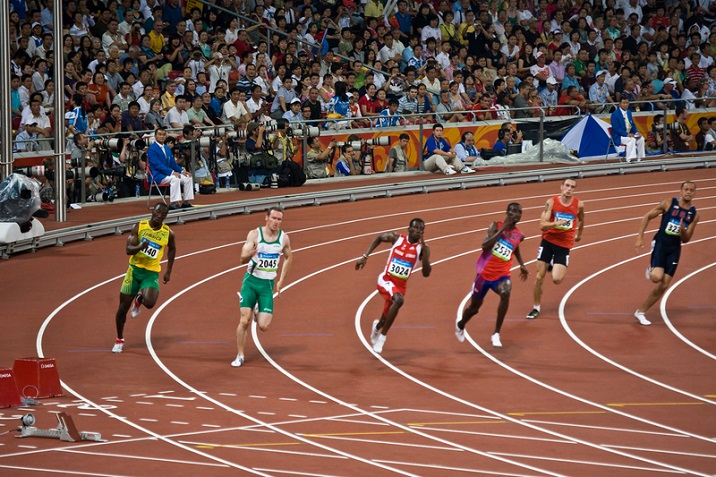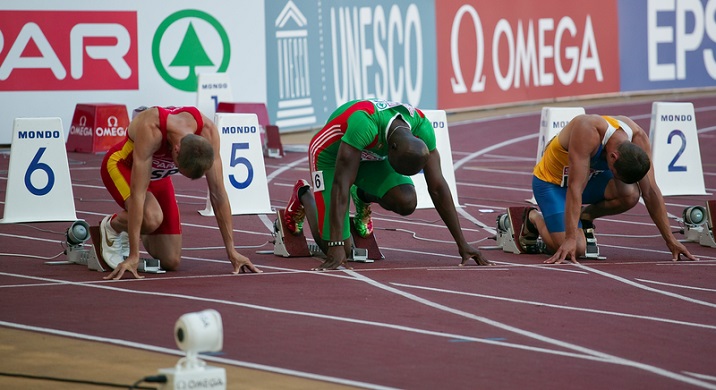
Running - Quick Guide
Running - Overview
Running is an important branch of Athletics and is also closely associated with the history of Olympics. Running races in international competitions are broadly divided into Sprints, Middle distances, and Long distances.
Sprints
Sprints are short distance running competitions, usually held for distances of 100 meters, 200 meters and 400 meters. Athletes concentrate on reaching the destination with their maximum speed. A 60-meter sprint race is also conducted in indoor championships.
Middle and Long Distance Running
These races are usually 800 meters, 1500 meters, 5000 meters, and 10000 meters. Athletes participating in these races not only concentrate on running faster, but also on maintaining a high constant speed. Such running races are designed to test the athletes strength and endurance.

Running Participating Countries
Running races are held throughout the world. Member federations of IAAF, the international regulating body of Athletics, organize athletic championships throughout the world. Though Americans and African athletes have been more successful in Running competitions, many Asian countries also participate in various international competitions.
Many of the worlds male sprinting champions are from the United States and Jamaica. The middle and long distance runners of Kenya and North Africa performed well in the recent Olympics, however runners from Great Brittan and USA dominated many of the previous Olympics. Russian women athletes give a tough competition to North African in the 1500 meter races.
East and North Africans are considered to be more athletic and good at running longer distances than their counterparts. Athletes from Kenya, Ethiopia, Tanzania, Uganda, Morocco and Algeria enjoyed success in long distance competitions of 5000 meters.
Chinese women athletes are also ranked high in long distance 10000 meter running along with Ethiopian athletes. Most prominent long distance male runners are from Kenya and Ethiopia. Recently athletes of Bahrain, Qatar, Saudi Arabia, and UAE won many medals in Asian Championships.
Running - Playing Environment
Track Design
Running competitions are held either on Outdoor Tracks or Indoor Tracks.
Outdoor Tracks − Running races can be conducted both indoors and outdoors. In international competitions, outdoor tracks are oval shaped and they encompass the field used for various field events.
Indoor Tracks − World indoor athletic championships are held in indoor tracks. The indoor track is also an oval shaped track with measurements similar to that of outdoors, but it has a 60-meter straight track across the length of the oval. This is used for the 60-meter sprint race.
Types of Racing in 400 m Track
The oval track is a 400-meter track with parallel lanes. For the 100-meters sprint races runners run in straight lanes, for the 200-meter sprint races runners run at the bend of the track for 100 meters and the other 100 meters in a straight line. For 400 meters race, runners run around the track and complete a circle.
Athletes participating in the 800-meter race run around the track twice, and in 1500 meter race they run around the track three times and have to cover 300 meters more or another three fourths of the track to finish the race.
Running Equipment
Running doesnt require anything more than your ambition to participate in official competitions. You need good shoes and clothes that adhere to the rules of the sport.

Shoes − Shoes used in professional running races are different from the ones used for walking and marathons. They dont have heels and have eleven crampons. The crampons cannot be more than 11 mm in length.
Clothes − Male runners wear jerseys and shorts, while women runners wear tank tops and shorts. Runners also wear comfortable socks and shoe cushions.
Running - Terms
Before knowing the rules and the procedure for racing, lets get familiar with some common terms used in this sport.
Starting Blocks − Starting blocks are provided at the starting points in most sprint races. These blocks have sensors to record starting time and pressure. They provide grip and help athletes to push themselves at the start.
False Start − Once the starting signal is given, players usually take more than 0.1 seconds to respond to it and start running. A player who reacts before 0.1 seconds is disqualified.
Starting lines − Starting lines are 50 mm wide lines in white that indicate the starting point in a race. In a straight 100-meter race, the lines are all straight; in the 200 meter and 400 meter race the lines are staggered or curved so that each athlete runs equal distances to finish the race.
Finish line − The finish line is a 50 mm wide line marked across the track. It usually is a straight line perpendicular to the sides of the track and is at the straight part of the track. If it is at the curved part of the track, it is marked along the radius.
Break lines − Break lines are 50 mm wide arced lines and indicate the end of a bend. Small cones or prisms of any color other than white are sometimes placed on the lines separating lanes before the break lines start.
Running - How to Play?
Before the tournament starts, players positions, the number of heats, and the number of rounds are decided by the organizing committee.
Getting Ready
In sprints athletes take crouch position and in longer races, athletes should start the race from standing position. Here no starting blocks are used. They take respective positions in the lane before the starting line, when they hear on your marks call.
During sprint races, the set position is taken on the next call, firmly placing feet on starting blocks and taking crouch position. For longer races, there is no set call as they start their race in standing position. For the 800-meter race, athletes start from staggered starting points. For the 1500-meter race, athletes make a bunched start in standing position.

A Quick Glimpse of the Sport
Heres how a typical race proceeds −
Runners occupy respective positions in call.
They start once they hear the starting gunshot.
They run in their respective lanes along the race track.
The race finishes when any part of the athletes body crosses the vertical plane of the finish line.
Winning a Race
Each race is divided into various rounds and each round may be held in many heats to accommodate all athletes.
The contesting athletes records and past achievements are considered while dividing athletes among heats. It is done so that the most successful athletes reach the finals.
Though athletes might be randomly placed in the first round, athletes who advance by place and time are recorded. These records are considered while seeding them in heats in subsequent rounds.
Usually two to three top performers from each heat participate in the subsequent races.
The one who reaches the finish line first in the final is the winner.
Running - Rules
The runners should abide by the following rules in order to complete a race −
Sprinters should run in designated lanes and cannot cross lanes, throughout the race.
In races with bunched starts, athletes can break inside. In 800-meter race, they start from staggered positions and can break inside after the first bend.
In longer races of 1500 meters, 5000 meters, and 10000 meters, athletes can break inside after the start.
Sprinters shouldnt step on white lines that mark their lanes throughout the race.
Sensors are placed in the starting pistol and at the blocks. In case of a false start, the athlete is disqualified.
Before giving the set command or before firing the starter gun, athletes cannot touch the other side of the start line with their hands or feet.
Athletes should not obstruct other athletes during the race.
If an athlete is obstructed, the referee may order the race to be held again, or he may ask the athlete to take part in the next round.
Athletes may leave the track voluntarily before the race ends, but they cannot come back to the track else they will be disqualified.

Running - Champions
Running races are an indispensable part of all Athletic championships. They are also a part of Olympic since the ancient times. Many racing tournaments are held globally. Some of them are as follows −
IAAF World Championships
IAAF World Indoor Championships
Regional Championships (Pan- American, African, Asian, European Games)
Olympics
Here is a brief synopsis on some of the champions of this sport.
Usain Bolt
Usain Bolt is a Sprinter from Jamaica who has one Olympic medals nine times in 100m, 200m, and 4 x 100m relay races. In 2008, he won double sprint.
He has won eleven medals in World Championships of which he has won gold medals consecutively from 2009 to 2015.
Only in 2011, he could not win the medal due to false start. Due to his achievements he has been named as lightning bolt.
Tyson Gay
Tyson Gay is an American sprinter who has won many medals in major world competitions. He is considered as second best runner after Usain Bolt.
In 2007 Osaka World Championships, he won gold medals in 100m, 200m and 4 x 100m relay races. In 2009, he won a silver medal in World Championships.
He has won Jesse Owen Award two times. He also got AAF World Athlete of the Year in 2007.
Yohan Blake
Yohan Blake is a sprinter from Jamaica who has won many medals in major world competitions. He has won one gold medal each in 2012 and 2016 Olympics in 4 x 100m relay races and two silver medals one in 100m and one in 200m race.
He has won two gold medals in World championships one in 100m and other in 4 x 100m relay race.
In World Relays, he has won two golds one in 4 x 100m and the other in 4 x 200m relay races. He has also won many medals in junior competitions.
Michael Johnson
Michael Johnson is a sprinter from America who has won many medals in major world competitions. He has won four golds in Olympics.
In 1992 Olympics, he won a gold in 4 x 400m relay race. In 1996 Olympics, he won one gold in 200m and one gold in 400m sprints.
In 2000 Olympics, he won a gold in 400m sprint. He has also won eight gold medals in World Championships in different categories. He won two golds in 200m, four golds in 400m and two golds in 4 x 100m relay race.
Florence Griffith-Joyner
Florence Griffith Joyner is an athlete from America. She has set records in 1988 in 100m and 200m which are yet to be broken and hence she is considered as the fastest women. In her career, she has won seven medals which includes four golds and three silvers.
She has won three gold medals in 1988 Seoul Olympics one each in 100m, 200m, and 4 x 100m relay race.
She has also won two silvers one in 1984 Olympics in 200m and the other in 4 x 400m in relay race.
Carmelita Jeter
Carmelita Jeter is a sprinter from America who has won medals in Olympics, World Championships, and other major competitions.
In 2012 Olympics, she won one gold in 4 x 100m relay, one silver in 100m, and one bronze in 200m races.
In World Championships, she has won seven medals three golds, one silver, and three bronzes.
She has won one silver in World Indoor Championships and one silver n World Relay Championships. She has also won two golds in World Athletics Finals.